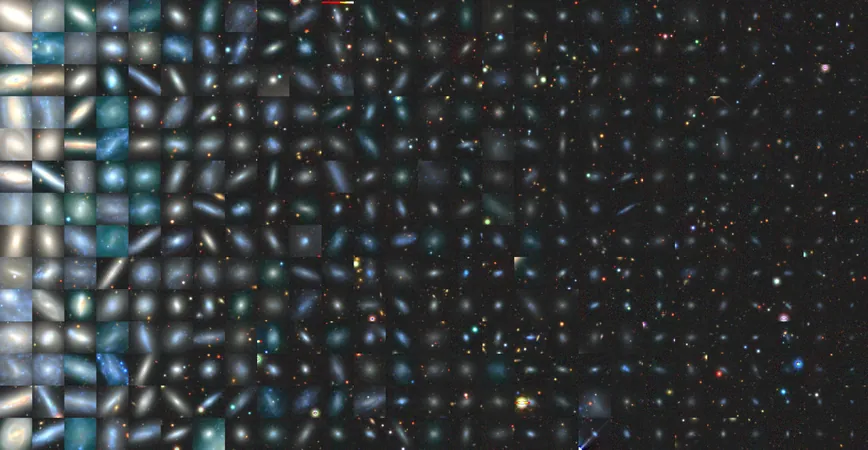
The Milky Way's Cosmic Mystique: New Findings Illuminate Its Oddities!
2024-09-25
Is the Milky Way galaxy truly unique among its cosmic peers?
A dedicated team of scientists has sought to unravel this cosmic mystery over the past decade. Originating in 2013, the Satellites Around Galactic Analogs (SAGA) Survey has meticulously examined galaxy systems that mirror the characteristics of our own Milky Way. In an exciting development, three research articles derived from the SAGA Survey have recently been published on the arXiv preprint server, providing groundbreaking insights into our galaxy’s distinctiveness after analyzing 101 satellite systems comparable to our own.
Understanding Satellite Galaxies
In astronomical terms, "satellites" refer to smaller galaxies in both mass and size that orbit a more massive "host" galaxy. Just like moons orbit planets, these satellite galaxies are bound by the gravitational forces of their host and its encompassing dark matter. The Milky Way itself boasts several satellite galaxies, the most prominent being the Large and Small Magellanic Clouds (LMC and SMC), which are visible to the naked eye from the Southern Hemisphere. However, there is a plethora of dimmer satellite galaxies encircling the Milky Way, observable only with powerful telescopes.
The heart of the SAGA Survey is to define and characterize satellite systems orbiting host galaxies that share similar stellar masses with our Milky Way. Key figures in this monumental project include Yao-Yuan Mao from the University of Utah, Marla Geha from Yale University, and Risa Wechsler from Stanford University, who are at the forefront of this astronomical exploration.
A Surprising Anomaly?
In the first article of the newly released series, Mao’s team identified a total of 378 satellite galaxies across 101 galaxies akin to the Milky Way. The number of confirmed satellites ranged from none at all to 13 for each system, while our Milky Way hosts only four confirmed satellites. Surprisingly, the SAGA findings suggest that the Milky Way could be an outlier when considering the presence of its massive satellite, the LMC.
Mao pointed out, “The Milky Way appears to host fewer satellites when factoring in the existence of the LMC.” The data indicates that galaxies with significant satellites, like the LMC, tend to possess a higher overall number of satellites, making the Milky Way's lower count particularly puzzling.
The hypothesis put forth suggests that the Milky Way has recently acquired the LMC and SMC compared to the universe's age. This leads to an intriguing conclusion: if the Milky Way is indeed older and less massive, we would expect to see a smaller total number of satellites. This finding underscores the necessity of comprehensively understanding the interactions between host galaxies and their satellites to accurately interpret observations pertaining to the Milky Way.
The Mystery of Star Formation Halts
The second study in this series, led by Marla Geha, raises an essential question: why do some satellite galaxies cease star formation? The research team uncovered a striking correlation: satellite galaxies located nearer to their host are significantly more likely to have their star formation processes "quenched." This suggests that environmental factors play a crucial role in determining the life cycles of smaller satellite galaxies.
In a related vein, the third study—led by Yunchong (Richie) Wang—leverages SAGA data to enhance existing theoretical models of galaxy formation. The investigation into the number of quenched galaxies within Milky Way-like systems posits that similar quenched galaxies could also emerge in isolated environments—a hypothesis that future astronomical studies, such as the Dark Energy Spectroscopic Instrument Survey, may validate.
A Stellar Contribution to Astronomy
In addition to these exciting revelations, the SAGA Survey team has generously contributed a treasure trove of information to the astronomy community. They published new redshift measurements for approximately 46,000 galaxies, dramatically broadening the scope of potential research topics.
Mao described the challenging nature of this endeavor, comparing the search for satellite galaxies to “finding needles in a haystack.” He remarked, “We had to measure the redshifts for hundreds of galaxies just to identify one satellite galaxy. These new galaxy redshifts will empower the astronomy community to explore a myriad of topics beyond the satellite galaxies themselves.”
As scientists continue to unlock the mysteries of the Milky Way and its neighboring galaxies, these findings promise to reshape our understanding of the cosmos and the complex interplay between galaxies. Keep an eye on the stars—who knows what other cosmic secrets await discovery!


 Brasil (PT)
Brasil (PT)
 Canada (EN)
Canada (EN)
 Chile (ES)
Chile (ES)
 España (ES)
España (ES)
 France (FR)
France (FR)
 Hong Kong (EN)
Hong Kong (EN)
 Italia (IT)
Italia (IT)
 日本 (JA)
日本 (JA)
 Magyarország (HU)
Magyarország (HU)
 Norge (NO)
Norge (NO)
 Polska (PL)
Polska (PL)
 Schweiz (DE)
Schweiz (DE)
 Singapore (EN)
Singapore (EN)
 Sverige (SV)
Sverige (SV)
 Suomi (FI)
Suomi (FI)
 Türkiye (TR)
Türkiye (TR)